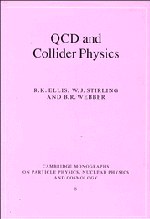Book contents
- Frontmatter
- Contents
- Preface
- 1 Fundamentals of QCD
- 2 Asymptotic freedom and confinement
- 3 QCD in electron-positron annihilation
- 4 Deep inelastic scattering
- 5 Parton branching and jet simulation
- 6 Jet properties beyond fixed order
- 7 Hadroproduction of jets and photons
- 8 Electroweak interactions
- 9 The production of vector bosons
- 10 Heavy quarks
- 11 Higgs bosons at high-energy colliders
- 12 Measurements of the strong coupling constant
- Index
1 - Fundamentals of QCD
Published online by Cambridge University Press: 05 May 2010
- Frontmatter
- Contents
- Preface
- 1 Fundamentals of QCD
- 2 Asymptotic freedom and confinement
- 3 QCD in electron-positron annihilation
- 4 Deep inelastic scattering
- 5 Parton branching and jet simulation
- 6 Jet properties beyond fixed order
- 7 Hadroproduction of jets and photons
- 8 Electroweak interactions
- 9 The production of vector bosons
- 10 Heavy quarks
- 11 Higgs bosons at high-energy colliders
- 12 Measurements of the strong coupling constant
- Index
Summary
The genesis of the theory which we now call Quantum Chromodynamics was the result of the assembling of many ideas and experimental results. In this chapter we start by reviewing the main evidence for the colour degree of freedom, which lies at the heart of the theory. We then write down the QCD Lagrangian and the Feynman rules which follow from it. We go on to discuss the exact and approximate symmetries of the theory.
Colour SU(3)
The most fundamental tenet of QCD is that hadronic matter is made of quarks. The idea of quarks arose from the need to have a physical manifestation for the SU(3) of flavour [SU(3)ƒ] observed in the spectrum of the lowest-mass mesons and baryons. The properties of the six known quarks are shown in Table 1.1. The observed baryons are interpreted as three-quark states. The quark constituents of the baryons are forced to have half-integral spin in order to account for the spins of the low-mass baryons. The quarks in the spin-3/2 baryons are then in a symmetrical state of space, spin and SU(3)ƒ degrees of freedom. However the requirements of Fermi-Dirac statistics imply the total antisymmetry of the wave function. The resolution of this dilemma was the introduction of the colour degree of freedom: a colour index a with three possible values (usually called red, green, blue for a = 1, 2, 3) is carried by each quark. The baryon wave functions are totally antisymmetric in this new index.
- Type
- Chapter
- Information
- QCD and Collider Physics , pp. 1 - 21Publisher: Cambridge University PressPrint publication year: 1996
- 2
- Cited by



